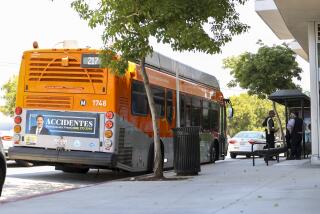Time Has Come for Valley to Take Control of Its Transit Needs
- Share via
For 10 years, people have talked about creating a transportation zone in the San Fernando Valley. It’s time to stop talking and take action. With our bus system eroding and a long list of broken promises for rail, the Valley needs to take control of its transportation system.
Earlier this month, the City Council approved a motion I sponsored directing the city Department of Transportation to report back to the council by the end of November on the possibility of developing a Valley transportation zone. The motion was seconded by the six other council members who represent the Valley.
If a transportation zone is created, it would be a sub-authority under the MTA, not a separate organization, and it would have to meet certain criteria before it could be established. A municipality, such as Los Angeles, would first have to apply to the MTA. The applicant would have to be able to provide 5% in matching funds to the transportation zone (Los Angeles already provides in excess of this to the Valley’s transportation system) and would have to demonstrate that there would be a 25% savings on the cost of delivering service. The MTA would have to agree to the proposal because it would require a restructuring within its organization. A zone would have to be a mutually agreed-upon, collaborative relationship between the MTA and city that would improve service.
If created, a transportation zone would provide the Valley with the autonomy to oversee the spending of its transportation resources and the authority to make management and programming decisions within the geographic boundaries of the zone. The concept already has been successfully demonstrated in the San Gabriel Valley, where 27 cities formed Foothill Transit, which has not only decreased the cost of providing bus service by more than 25%, but also improved its quality and frequency. By having an MTA sub-authority in the Valley, the MTA would be able to focus on improving bus service citywide, completing capital projects, meeting the requirements of the federal court-order consent decree and maintaining its commitment to paying off debt. A transportation zone would give the Valley an opportunity to develop a system that works for its businesses and residents. It would not affect the current seamless bus system that allows patrons to transfer between separate service providers.
In 1980 and 1990, voters approved two separate half-cent sales tax increases, Propositions A and C, with strong support from Valley voters. These measures, combined with financial support from the city, state and federal governments and the creation of the MTA in 1993, were supposed to solve the region’s transportation problems by providing a cohesively planned and operational bus system and a rail line in the Valley by the year 2000.
After spending more than $1 billion in Valley tax dollars, neither of these promises has come to fruition. The MTA’s latest plans show the Valley east-west rail line not being completed until 2014. Most people consider this target overly optimistic; in fact, many believe the Valley rail line may never be built.
Our bus system is in no better shape. Despite spending nearly $85 million annually on Valley bus services and having the consent decree for service improvements, the MTA continues to let quality decline. Fewer buses are being operated, and transit ridership continually decreases, despite population growth. Transit-dependent riders suffer from unreliable, overcrowded and unsafe service, even though the MTA staff realizes that if the entire rail system is built, buses will continue to carry nearly 80% of all transit riders.
In addition, half of the MTA’s 2,450 buses either exceed federal replacement guidelines due to age and mileage or are part of the chronically inoperable ethanol-fuel-powered fleet. The MTA has yet to budget to replace these much-needed buses and has not expanded the bus system since the 1984 Olympics.
This is why we need to explore creating a transportation zone. In a Nov. 2 editorial, The Times questioned creating such an entity, stating there is already Valley representation on the City Council and MTA board. It is this representation that has asked the Department of Transportation to explore creating a transportation zone in the Valley in an effort to give our constituents a decent transportation system while also enabling the MTA to provide better service to the county’s transit users.
A transportation zone won’t happen overnight, but for the first time in decades, the City Council is taking action to help the Valley take control of its bus system. If a transportation zone would reduce costs and improve bus service, it should be seriously considered because this goal is also in concert with the MTA’s mission and will benefit us all.
More to Read
Sign up for Essential California
The most important California stories and recommendations in your inbox every morning.
You may occasionally receive promotional content from the Los Angeles Times.













